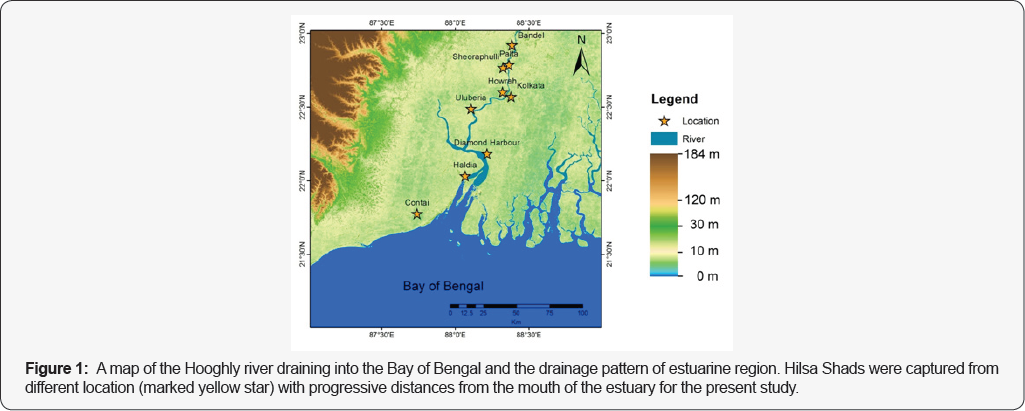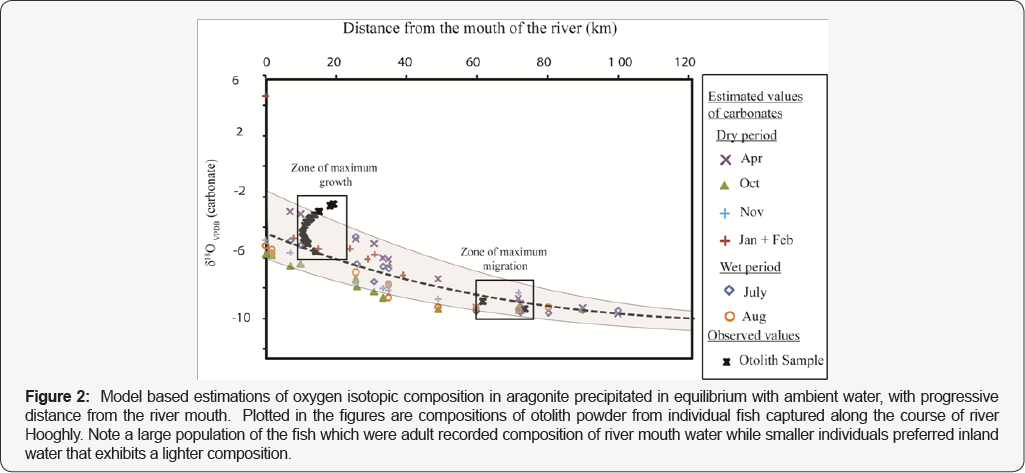Observations on Habitats for the Growth of Tenualosa ilisha Population in the Hooghly River Estuary, West Bengal, India Revealed From Isotopic Analysis of Ear Bone (Otolith) Carbonate- Juniper Publishers
Juniper Publishers- Journal of Oceanography
Short Communication
The exotic taste of Hilsa shad (Tenualosa ilisha, Clupeidae) makes it one of the most economically significant edible fish communities found in the water of Bengal estuaries. A large part of the local inhabitants in and around the southern zones of West Bengal depends on the production of Hilsa in the estuarine water. However it has been reported recently that the average dimension of individuals from this Hilsa shad community are on a decline than those found in Bangladesh waters [1]. Pollutants mixing with the waters from anthropogenic sources and over exploitation without proper monitoring in the habitat areas can be held responsible for troughs in production of Hilsa. This fish community is known for its anadromous behavior and can migrate up to the rivers for spawning process [2]. The migration pattern of Hilsa shad population is a major concern in fishery research to identify most beneficial fishing zones and proper maintenance of the state of conservation for further exploitation at commercial level. This study reveals a model based observation on the favourable habitats of individuals from a Hilsa shad population collected from Bengal estuarine water in the year of 2013-14 based on stable isotopic techniques.

The fishes used in this study were captured along the course of the Hooghly River in the downstream from the main channel of the river Ganges. The sample locations on map are shown in Figure 1. Sagittal otoliths were extracted from these sets of specimens of Hilsa shad after dissection and were separated from the saccule or utricle of the inner ear from all individuals. Otolith samples were then treated with H2O2 for 12 hours to clear out the labile organic matter and then were crushed into powder using an agate mortar and kept in clean glass vials. Isotopic analyses were carried out with acid digestion method [3], where in 0.2μg of otolith powder was reacted with 0.1ml of 105% phosphoric acid at a constant bath temperature of 70 0C maintained in the Gas Bench II [4] and followed by isotopic analyses of produced CO2 using a MAT 253 Isotope Ratio Mass Spectrometer [3,5]. The reproducibility of NBS-19 calcite for δ18O was 0.03 as ±0.08%o and results were reported in VPDB scale.
The carbonates of otolith were found to be aragonitic in nature. The Stable oxygen isotope ratio of aragonite in otoliths is controlled by temperature and isotopic composition of the river water [6]. The measured δ18O values of otoliths were compared with inferred composition of carbonate assuming an equilibrium relationship between water and aragonite mineral at known ambient temperatures. Samanta et al. [7] provided salinity and temperature data for locations, lying at different distances from the coast, in the studied area for the months of2012-2013. Salinity data were then converted into δ18O of water (δ18Ow) for different seasons using the empirical relationship [8,9]. The deduction of the δ18Ow-δ18Oarag relationship generally requires the knowledge of δ18Ow and temperature variations. Fractionation-temperature relationship of Grossman & Ku [10] was used in this study. Estimated δ18Oarg for different months at variable distances from the coast of the Hooghly River were plotted. All the distances were measured taking into consideration the geometry of river channel and placing Bakkhali (Lat. 21.563°, Long. 88.259°); a coastal station as zero. The polynomial equation governing the isotopic composition of aragonite with distance is expressed as, Distance=2.48 x (δ18Ootolith)2+21.6 x δ18Ootolith + 57.7 (r2= 0.88). Alongside the model based estimation of δ18Oarg values, the same from otolith carbonate samples from the present study were plotted and compared with the estimated data (Figure 2). The locations near mouth of the river or in close proximity to the Bay show enriched δ18Oarg values where as the distant ones show much depleted values which is clear from the model. The otolith carbonate compositions from Hilsa shad population reflect the same trend. It was seen from the results (Figure 2) that maximum adult individual plot near the mouth of the river, approximately 10-20km from the coast which is believed to be the zone where the individuals had spent the most of their life span. At the same time smaller individuals remain at a significant distance from the coast, approximately 60-80km from the coastal region [11-13].

In this study we used well controlled Hilsa fish samples for extraction of otolith carbonates and deriving the zones of maximum growth and their preferred habitat. The oxygen stable isotope composition ofthe otolith carbonates has a strong relation with the progressive distance from the coastal area towards inland water. Using isotopic tools we designed a technique to observe the favoured habitats and zones of maximum growth for individuals of Hilsa shad population in Bengal estuarine waters. There are scopes for future investigation to probe if there are changes in pattern of Hilsa shad habitats in connection to the effects of climate change at regional level.
To Know More About Journal of Oceanography Please Click on: https://juniperpublishers.com/ofoaj/index.php
Comments
Post a Comment